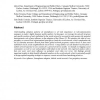Free Online Productivity Tools
i2Speak
i2Symbol
i2OCR
iTex2Img
iWeb2Print
iWeb2Shot
i2Type
iPdf2Split
iPdf2Merge
i2Bopomofo
i2Arabic
i2Style
i2Image
i2PDF
iLatex2Rtf
Sci2ools
CORR
2016
Springer
2016
Springer
Asymmetric Peer Influence in Smartphone Adoption in a Large Mobile Network
Understanding adoption patterns of smartphones is of vital importance to telecommunication managers in today’s highly dynamic mobile markets. In this paper, we leverage the network structure and specific position of each individual in the social network to account for and measure the potential heterogeneous role of peer influence in the adoption of the iPhone 3G. We introduce the idea of coreperiphery as a meso-level organizational principle to study the social network, which complements the use of centrality measures derived from either global network properties (macro-level) or from each individual's local social neighbourhood (micro-level). Using millions of call detailed records from a mobile network operator in one country for a period of eleven months, we identify overlapping social communities as well as core and periphery individuals in the network. Our empirical analysis shows that core users exert more influence on periphery users than vice versa. Our findings provide...
| Added | 01 Apr 2016 |
| Updated | 01 Apr 2016 |
| Type | Journal |
| Year | 2016 |
| Where | CORR |
| Authors | Qiwei Han, Pedro Ferreira, João Paulo Costeira |
Comments (0)

